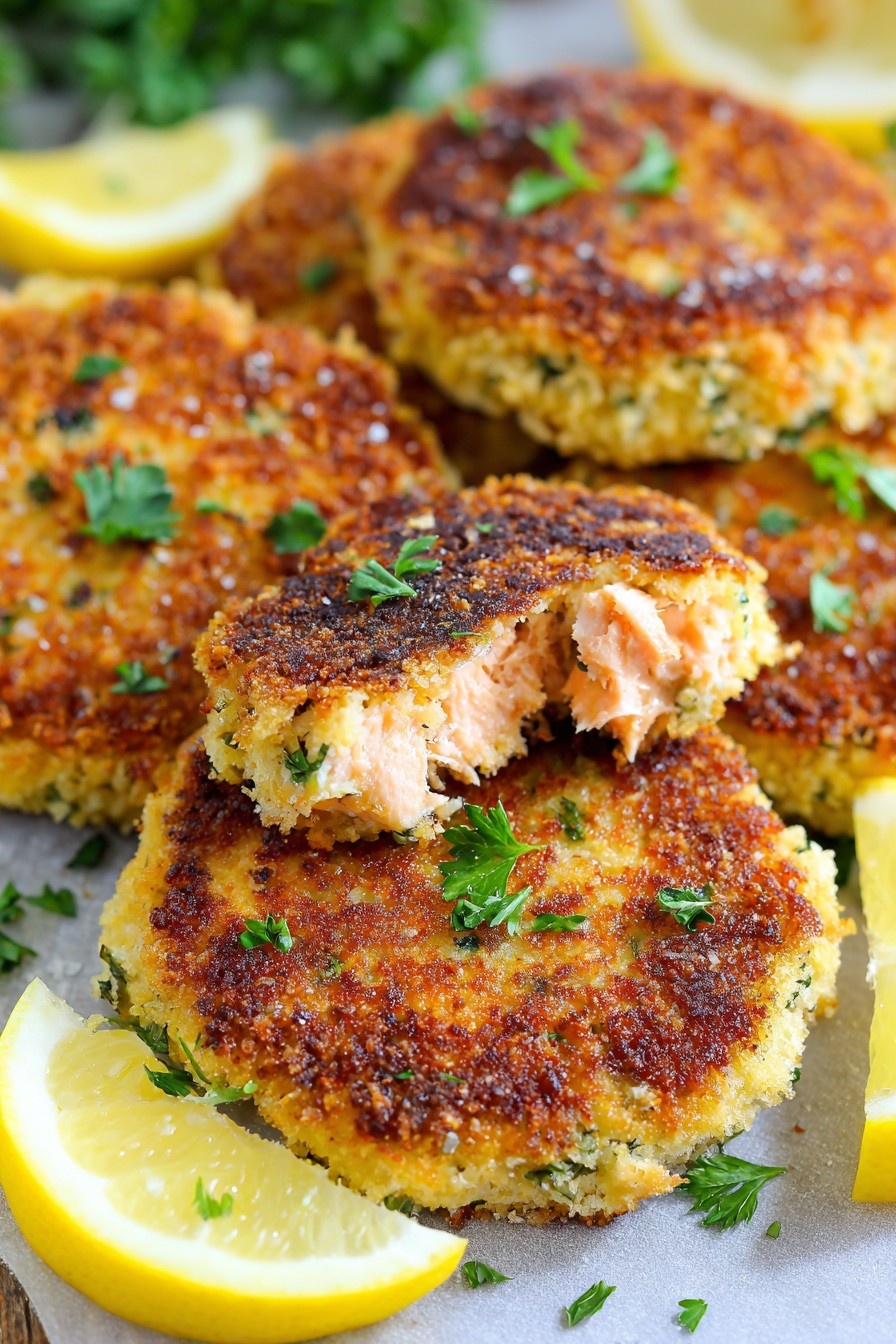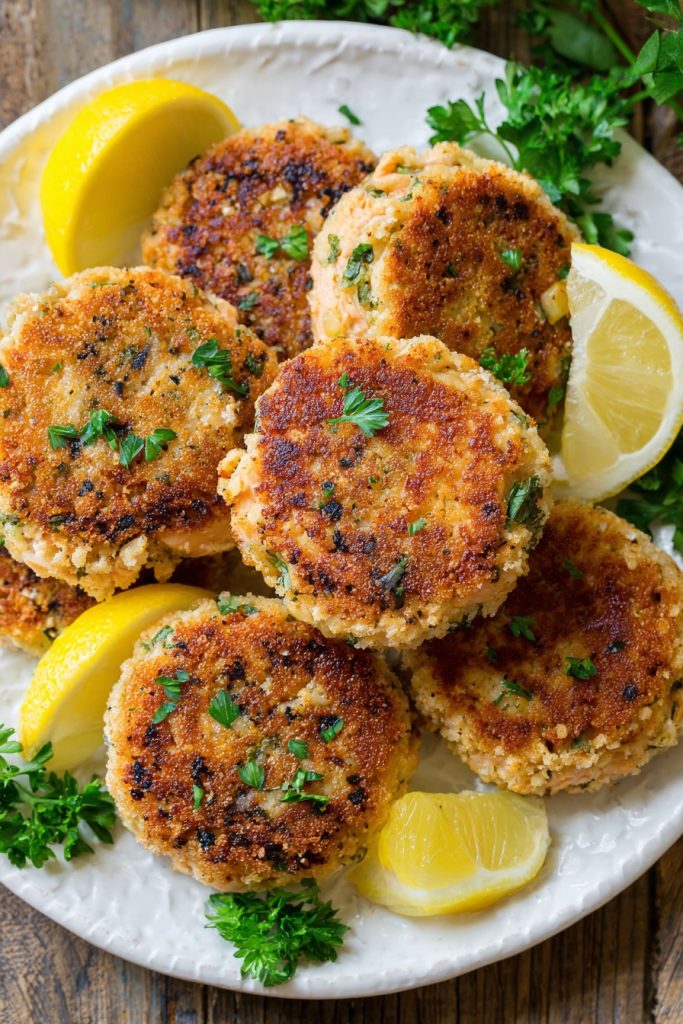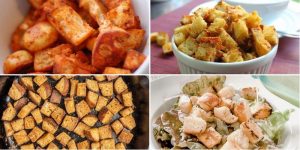A cherished memory from my childhood kitchen always comes flooding back whenever I catch that distinct aroma of salmon patties sizzling in the skillet. As a little girl, I’d perch on the worn wooden stool by the counter, watching my grandmother’s weathered hands gently form those perfect golden patties that promised comfort in every bite. Those simple Wednesday night dinners taught me that the most extraordinary meals often come from the humblest ingredients, creating traditions that span generations.
Why This Recipe Works
This recipe transforms ordinary canned salmon into extraordinary comfort food through several key approaches. First, the combination of panko breadcrumbs and crushed saltines creates the perfect textural balance – crisp on the outside while remaining tender and moist inside, just like my grandmother achieved every time. Second, using both fresh herbs and dried seasonings builds layers of flavor that elevate the humble canned salmon to something truly special. Third, the addition of finely minced vegetables not only adds nutritional value but creates pockets of sweetness and crunch that complement the rich salmon perfectly. Finally, the pan-frying method developed over generations in our family kitchen ensures that beautiful golden-brown crust that makes these patties irresistible.
Ingredients
– 2 (14.75 ounce) cans pink salmon, drained and flaked
– 1 large egg, lightly beaten
– 1/2 cup panko breadcrumbs
– 1/2 cup crushed saltine crackers (about 12 crackers)
– 1/4 cup finely diced yellow onion
– 2 tablespoons finely chopped fresh parsley
– 1 tablespoon mayonnaise
– 1 teaspoon Worcestershire sauce
– 1/2 teaspoon garlic powder
– 1/2 teaspoon Old Bay seasoning
– 1/4 teaspoon black pepper
– 1/4 cup vegetable oil for frying
– Lemon wedges for serving
Equipment Needed
– Large mixing bowl
– Medium skillet
– Measuring cups and spoons
– Mixing spoon
– Spatula
– Paper towel-lined plate
– Can opener
Instructions

Prepare the Salmon Mixture
Begin by carefully draining both cans of salmon, then transfer the salmon to your large mixing bowl. Using a fork, gently flake the salmon, being sure to remove any larger bones or skin pieces if desired – though my grandmother always insisted those tiny bones added extra calcium. In goes the lightly beaten egg, which acts as our binding agent, followed by the panko breadcrumbs and crushed saltines that will create that wonderful texture we’re after. Now add the finely diced yellow onion, taking care to chop it small enough that it cooks through properly but still provides little bursts of flavor. The fresh parsley brings that garden-fresh brightness, while the mayonnaise adds moisture and helps everything hold together beautifully. Finally, season with Worcestershire sauce, garlic powder, Old Bay seasoning, and black pepper, mixing everything gently with your hands just until combined – overmixing will make the patties tough. The mixture should hold together when pressed but still feel moist; if it seems too wet, add another tablespoon of breadcrumbs.
Form the Patties
With clean hands, divide the salmon mixture into eight equal portions, each about 1/3 cup in size. Gently shape each portion into a patty about 3/4-inch thick, being careful not to pack them too tightly – we want tender patties, not dense hockey pucks. As you form each patty, press your thumb gently into the center to create a slight indentation; this little trick prevents the patties from puffing up in the middle during cooking. Place the formed patties on a plate or baking sheet as you work, and if time allows, refrigerate them for 15-20 minutes to help them firm up. This resting period makes them much easier to handle when it’s time to cook and helps prevent breaking during the flipping process. The patties should hold their shape well but still feel delicate – that’s the sign of perfectly mixed salmon cakes ready for the skillet.
Heat the Skillet
Place your medium skillet over medium heat and add the 1/4 cup of vegetable oil. Allow the oil to heat until it shimmers and moves fluidly across the pan surface, which typically takes about 3-4 minutes. To test if the oil is ready, carefully sprinkle a tiny breadcrumb into the oil – if it sizzles immediately and floats to the surface, you’re at the perfect temperature for frying. The oil should register between 350°F and 375°F on an instant-read thermometer if you’re using one. This temperature range ensures that the patties will develop that beautiful golden-brown crust without absorbing excess oil or burning. While the oil heats, arrange your paper towel-lined plate nearby for draining the cooked patties, and have your spatula ready for easy flipping.
Cook the First Side
Carefully place four patties into the hot oil, being sure not to overcrowd the skillet – they need space to develop that perfect crust. You should hear an immediate sizzle when they hit the oil, that satisfying sound that takes me right back to my grandmother’s kitchen. Cook the patties undisturbed for 3-4 minutes, until the bottoms develop a deep golden-brown color and the edges begin to look cooked through. Resist the temptation to move them around or peek too early – this patience allows that beautiful crust to form properly. You’ll know they’re ready to flip when you can easily slide the spatula underneath without the patty sticking or breaking apart. The aroma filling your kitchen should be heavenly – that combination of frying salmon and herbs that signals comfort food at its finest.
Flip and Finish Cooking
Using your spatula, gently flip each patty to cook the second side. They should release easily from the skillet if they’ve developed that proper crust. Continue cooking for another 3-4 minutes, until the second side matches the first in that perfect golden-brown color and the patties feel firm to the touch. The internal temperature should reach at least 145°F if you’re checking with a thermometer, though the visual cues are usually sufficient. If you notice the patties browning too quickly, reduce the heat slightly to prevent burning while ensuring they cook through completely. That sizzle will gradually quiet down as they near completion, another sign that they’re almost ready to come out of the pan.
Drain and Serve
Transfer the cooked patties to your paper towel-lined plate to drain any excess oil, then repeat the cooking process with the remaining four patties. As you cook the second batch, keep the first batch warm in a 200°F oven if desired, though they’re wonderful served immediately. The patties should be served hot, with lemon wedges for squeezing over the top – that bright citrus note cuts through the richness beautifully. These salmon patties pair wonderfully with simple sides like steamed green beans, coleslaw, or mashed potatoes, creating that complete comfort meal that feels like a warm hug from generations past. Leftovers reheat beautifully in a 350°F oven for about 10 minutes, though they rarely last that long in our household.
Tips and Tricks
For those looking to elevate their salmon patty game beyond the basics, I’ve gathered some wisdom passed down through family kitchens and my own experimentation. When selecting canned salmon, don’t automatically reach for the boneless, skinless varieties – the bones in traditional canned salmon are soft, edible, and packed with calcium, plus they help the patties hold their shape better. If you do prefer boneless, consider adding an extra tablespoon of breadcrumbs to compensate. For the crispiest exterior, make sure your oil is properly heated before adding the patties – that immediate sizzle is crucial for creating that perfect crust rather than greasy cakes. If you’re watching your oil intake, these can be baked at 400°F for 15-20 minutes on a parchment-lined baking sheet sprayed with cooking spray, though you’ll sacrifice some of that traditional fried texture. For extra flavor depth, consider sautéing your onions in a teaspoon of butter until translucent before adding them to the mixture – this simple step caramelizes their natural sugars and eliminates any harsh raw onion taste. If your mixture seems too wet after refrigeration, don’t panic – just add another tablespoon of breadcrumbs until it reaches the right consistency. For make-ahead convenience, you can form the patties and refrigerate them for up to 24 hours before cooking, or freeze them on a baking sheet then transfer to freezer bags for up to three months – just add a couple minutes to the cooking time if cooking from frozen. The type of crackers you use can dramatically change the character of your patties – saltines provide that classic flavor, but Ritz crackers add buttery richness, while whole wheat crackers offer nutty depth. Finally, don’t underestimate the power of proper draining – letting those cooked patties rest on paper towels for just a minute or two makes all the difference between greasy and perfectly crisp.
Recipe Variations
While the classic salmon patty will always hold a special place in my heart, part of the beauty of this recipe is how easily it adapts to different tastes and occasions. For a Southwest twist, add 1/4 cup of corn kernels, 2 tablespoons of chopped cilantro instead of parsley, 1 teaspoon of chili powder, and a diced jalapeño for heat – serve these with avocado slices and a squeeze of lime for a completely different experience. If you’re craving Mediterranean flavors, substitute the parsley with 2 tablespoons each of fresh dill and mint, add 1/4 cup of crumbled feta cheese, and replace the Worcestershire with lemon juice – these pair beautifully with tzatziki sauce and a Greek salad. For an Asian-inspired version, use panko breadcrumbs as directed but add 1 tablespoon of soy sauce, 1 teaspoon of grated fresh ginger, 2 chopped green onions, and 1 teaspoon of sesame oil – serve with steamed rice and a quick soy-ginger dipping sauce. If you want to lighten things up, replace half the salmon with an equal amount of mashed sweet potato and use whole wheat breadcrumbs – the sweetness complements the salmon beautifully while adding extra nutrients. For a truly decadent treat, mix in 1/4 cup of cream cheese and 2 tablespoons of grated Parmesan – these become incredibly rich and creamy inside while maintaining that crispy exterior we all love.
Frequently Asked Questions
Can I use fresh salmon instead of canned?
While canned salmon provides that distinct texture and convenience that makes this recipe so accessible, you can absolutely use fresh cooked salmon if you prefer. You’ll need about 3 cups of flaked cooked salmon – either poached, baked, or leftover grilled salmon works beautifully. The key differences are that fresh salmon tends to be moister, so you may need to increase the breadcrumbs by a tablespoon or two to achieve the right consistency for forming patties. Fresh salmon also has a milder flavor profile compared to canned, so you might want to increase the seasonings slightly, particularly the Old Bay and Worcestershire sauce. The cooking method remains exactly the same, though fresh salmon patties might cook a minute faster since they start at room temperature rather than chilled from the can.
How can I make these gluten-free?
Creating gluten-free salmon patties is surprisingly simple and yields equally delicious results. Replace the panko breadcrumbs with an equal amount of gluten-free breadcrumbs or crushed gluten-free crackers – many brands now offer excellent alternatives that crisp up beautifully. For the saltines, use gluten-free crackers instead; several companies make gluten-free versions that mimic the texture and mild flavor of traditional saltines perfectly. Be sure to check your Worcestershire sauce as well, as some brands contain gluten – either use a certified gluten-free version or substitute with tamari or coconut aminos. The rest of the ingredients are naturally gluten-free, so with these simple swaps, you can enjoy the same comforting salmon patties while adhering to dietary restrictions.
What’s the best way to reheat leftovers?
While salmon patties are certainly best enjoyed fresh from the skillet, leftovers can be revived beautifully with the right reheating method. Avoid the microwave, which will make them soggy and rubbery – instead, use your oven or toaster oven. Preheat to 350°F and place the patties on a baking sheet, heating for 8-10 minutes until warmed through and crisp on the outside. For even better results, place them on a wire rack over the baking sheet to allow air circulation all around. If you’re reheating just one or two patties, a skillet over medium heat works wonderfully – add a teaspoon of oil and cook for 2-3 minutes per side until hot and crispy. The stovetop method actually recreates that fresh-fried texture almost perfectly.
Can I freeze uncooked salmon patties?
Freezing uncooked salmon patties is an excellent way to have comfort food ready at a moment’s notice, and they freeze remarkably well. After forming the patties, place them in a single layer on a parchment-lined baking sheet and freeze until solid, about 2-3 hours. This prevents them from sticking together later. Once frozen, transfer them to freezer bags, pressing out as much air as possible before sealing – they’ll keep for up to three months this way. When ready to cook, there’s no need to thaw – simply cook from frozen, adding 1-2 minutes per side to account for the colder temperature. The texture and flavor remain excellent, making this a fantastic meal prep option for busy families who still want homemade comfort food.
Why do my patties keep falling apart?
If your salmon patties are breaking apart during cooking, there are several common culprits and solutions. The most likely issue is insufficient binding agents – make sure you’re using the full egg and mayonnaise as specified, as these work together to hold everything together. Another common mistake is overmixing the ingredients – gentle mixing just until combined is key, as overworking the mixture breaks down the natural binding properties. If your mixture seems too wet, add another tablespoon of breadcrumbs until it holds together when pressed. Chilling the formed patties for 15-20 minutes before cooking helps them firm up significantly. Finally, make sure your oil is properly heated before adding the patties – if the oil isn’t hot enough, the patties will absorb oil and break apart rather than forming that protective crust.
Summary
This easy canned salmon patties recipe transforms simple pantry ingredients into golden, crispy comfort food that evokes cherished family memories. With perfect texture from panko and saltines, balanced flavors from fresh herbs and seasonings, and that satisfying pan-fried crust, these patties deliver homemade goodness in every bite. Whether served with lemon wedges for brightness or adapted with creative variations, they remain a timeless family favorite that connects generations through the shared experience of good food made with love.
Easy Canned Salmon Patties
6
servings15
minutes15
minutesIngredients
Instructions
- 1 In large bowl, combine drained salmon, egg, breadcrumbs, crushed crackers, onion, parsley, mayonnaise, Worcestershire sauce, garlic powder, Old Bay, and pepper. Mix gently until combined.
- 2 Divide mixture into 8 portions and form into 3/4-inch thick patties, making slight indentation in center of each.
- 3 Heat oil in skillet over medium heat until shimmering (350-375°F).
- 4 Cook 4 patties at a time for 3-4 minutes per side until golden brown and firm.
- 5 Drain on paper towels and repeat with remaining patties.
- 6 Serve hot with lemon wedges.



